Research on Orderly Charging Strategy for Electric Vehicles Based on Electricity Price Guidance and Reliability Evaluation of Microgrid
Abstract
:1. Introduction
- (1)
- The interactive relationship between the orderly charging and reliability of microgrid are analyzed, and the reliability of the microgrid can be improved via orderly charging;
- (2)
- By comprehensively considering the orderly charging and reliability evaluation of EVs, an orderly charging strategy for EVs based on TOU pricing guidance is proposed, which can effectively reduce the peak–valley load difference ratio and reduce the charging cost for users.
2. Modeling of EV Charging Load Characteristics
2.1. EV Charging Start Time
2.2. EV Charging End Time
2.3. EV Charging Time
2.4. EV Daily Mileage
3. Electricity Price Guidance and Orderly Charging Optimization
3.1. Electricity Price Guidance
3.2. Objective Function
- (1)
- Minimizing Peak–Valley Difference Ratio
- (2)
- Minimizing Total Charging Costs for EV Users
3.3. Constraint Conditions
- (1)
- Power Balance Constraint
- (2)
- ESS Charging and Discharging Constraint
- (3)
- EV SOC Constraint
4. The Workflow and Implementation of Elite Genetic Algorithm
5. Simulation Analysis
5.1. Basic Parameter Configuration
5.2. Analysis of EV Charging Optimization Effect Based on Electricity Price Guidance
5.2.1. Optimization Effect Analysis of a Certain Number of EVs
5.2.2. Analysis of the Optimization Effect of EV Number Changes
5.3. Analysis of the Influence of EV Orderly Charging on Reliability
5.3.1. Reliability Analysis for a Certain Number of EVs
5.3.2. Reliability Analysis for EV Number Changes
6. Conclusions
Author Contributions
Funding
Data Availability Statement
Conflicts of Interest
Appendix A
| Load Point Number | Peak Load/MW | Average Load/MW |
|---|---|---|
| 1, 6 | 0.2964 | 0.1659 |
| 2 | 0.3229 | 0.1808 |
| 3, 13, 17 | 0.6517 | 0.2501 |
| 4, 18 | 0.6860 | 0.2633 |
| 5 | 0.3698 | 0.2070 |
| 7, 23 | 0.7965 | 0.3057 |
| 8, 11, 14, 19 | 0.2776 | 0.1554 |
| 9, 21 | 0.7375 | 0.2831 |
| 10, 12, 16, 22 | 0.2831 | 0.1585 |
| 15, 20 | 0.5025 | 0.1929 |
| Hour | Percentages | Hour | Percentages |
|---|---|---|---|
| 0:00 | 0.7407 | 12:00 | 0.9133 |
| 1:00 | 0.6923 | 13:00 | 0.9531 |
| 2:00 | 0.6527 | 14:00 | 0.9392 |
| 3:00 | 0.6212 | 15:00 | 0.9489 |
| 4:00 | 0.5845 | 16:00 | 0.9758 |
| 5:00 | 0.5972 | 17:00 | 0.9893 |
| 6:00 | 0.6079 | 18:00 | 1 |
| 7:00 | 0.6227 | 19:00 | 0.9921 |
| 8:00 | 0.6410 | 20:00 | 0.9554 |
| 9:00 | 0.6939 | 21:00 | 0.9104 |
| 10:00 | 0.7498 | 22:00 | 0.8467 |
| 11:00 | 0.8621 | 23:00 | 0.8154 |
| Months | Percentages | Months | Percentages |
|---|---|---|---|
| 1 | 0.5959 | 7 | 0.9422 |
| 2 | 0.4973 | 8 | 1 |
| 3 | 0.4356 | 9 | 0.9695 |
| 4 | 0.4343 | 10 | 0.8081 |
| 5 | 0.5136 | 11 | 0.5305 |
| 6 | 0.7530 | 12 | 0.4861 |
References
- Sun, Y.Y.; Zhao, P.F.; Wang, L.W.; Malik, S.M. Spatial and temporal modelling of coupled power and transportation systems: A comprehensive review. Energy Convers. Econ. 2021, 2, 55–66. [Google Scholar] [CrossRef]
- International Energy Agency: Global EV Outlook 2023. Available online: https://iea.blob.core.windows.net/assets/dacf14d2-eabc-498a-8263-9f97fd5dc327/GEVO2023.pdf (accessed on 20 November 2023).
- BloombergNEF Electric Vehicle Outlook 2023. Available online: https://about.bnef.com/electric-vehicle-outlook/ (accessed on 20 November 2023).
- Mei, Y.; Li, B.; Wang, H.L.; Wang, X.L.; Michael, N. Multi-objective optimal scheduling of microgrid with electric vehicles. Energy Rep. 2022, 8, 4512–4524. [Google Scholar] [CrossRef]
- Zhou, J.H.; Weng, Z.P.; Song, X.T. Capacity configuration method of islanded microgrid with photovoltaic and energy storage system considering reliability and economy. Autom. Electr. Power Syst. 2021, 8, 166–174. [Google Scholar]
- Jiang, H.Y.; Ning, S.Y.; Ge, Q.B. Multi-objective optimal dispatching of microgrid with large-scale electric vehicles. IEEE Access 2019, 7, 145880–145888. [Google Scholar] [CrossRef]
- Zhang, Z.Y.; Lv, L.J. Status and development of research on orderly charging and discharging of electric vehicles. Electronics 2023, 9, 2041. [Google Scholar] [CrossRef]
- Khalid, M.R.; Alam, M.S.A.; Jamil Asghar, M.S. A comprehensive review on electric vehicles charging infrastructures and their impacts on power-quality of the utility grid. eTransportation 2019, 1, 100006. [Google Scholar] [CrossRef]
- Du, W.Y.; Ma, J.; Yin, W.J. Orderly charging strategy of electric vehicle based on improved PSO algorithm. Energy 2023, 271, 127088. [Google Scholar] [CrossRef]
- Crozier, C.; Morstyn, T.; McCulloch, M. The opportunity for smart charging to mitigate the impact of electric vehicles on transmission and distribution systems. Appl. Energy 2020, 268, 114973. [Google Scholar] [CrossRef]
- Li, H.J.; Lv, J.Q.; Chen, W.; Zeng, X.Q. Orderly charging model of private electric vehicle based on double sequence valley period. In Proceedings of the 2018 China International Conference on Electricity Distribution, Tianjin, China, 17–19 September 2018; pp. 2961–2965. [Google Scholar]
- Zuo, Q.; He, H.L.; Liang, C.H.; Zhou, M.; Zhou, Q.Y. Quantitative evaluation method of system acceptance capacity of electric vehicles in ordered charging mode. Proc. CSU-EPSA 2017, 6, 1–6. [Google Scholar]
- Li, L.; Li, X.H.; Liu, W.D.; Zhao, X.; Xie, Q.; Ge, L.J. An impact analysis of large-scale electric vehicle charging on reliability of small-regional distribution network. J. Henan Polytech. Univ. (Nat. Sci.) 2019, 5, 105–111. [Google Scholar]
- Wang, L.; Wan, Y.H.; Cao, W.T.; Cao, Y.H. Multi-objective orderly charging strategy for electric vehicles based on interactive network model. IEEJ Trans. Electr. Electron. Eng. 2021, 4, 519–525. [Google Scholar] [CrossRef]
- Tao, Y.; Huang, M.H.; Chen, Y.P.; Yang, L.S. Orderly charging strategy of battery electric vehicle driven by real-world driving data. Energy 2020, 193, 116806. [Google Scholar] [CrossRef]
- Goh, H.H.; Zong, L.; Zhang, D.D.; Wei, D.; Lim, C.S.; Kurniawan, T.A.; Goh, K.C. Orderly charging strategy based on optimal time of use price demand response of electric vehicles in distribution network. Energies 2022, 5, 1869. [Google Scholar] [CrossRef]
- Yang, A.; Wang, H.L.; Li, B.; Tan, Z.K. Capacity optimization of hybrid energy storage system for microgrid based on electric vehicles’ orderly charging/discharging strategy. J. Clean. Prod. 2023, 411, 137346. [Google Scholar] [CrossRef]
- Liu, L.P.; Yang, X.P.; Li, Y.L.; Zeng, Q.B. TOU price model of reliability optimization considering electricvehicles accessing. Guangdong Electr. Power 2017, 5, 56–62. [Google Scholar]
- Wu, S.C.; Pang, A.P. Optimal scheduling strategy for orderly charging and discharging of electric vehicles based on spatio-temporal characteristics. J. Clean. Prod. 2023, 392, 136318. [Google Scholar] [CrossRef]
- Gou, J.W.; Lin, C.S.; Li, J.; Geng, B.; Li, Z.; Cao, Y.; Li, Y.; Bao, Y.Q. Charging strategy for electric vehicles considering consumer psychology and trip chain. Front. Energy Res. 2021, 9, 723370. [Google Scholar] [CrossRef]
- Zhang, X.Z.; Wang, Z.Y.; Lu, Z.Y. Multi-objective load dispatch for microgrid with elec-tric vehicles using modifed gravitational search and particle swarm optimization al-gorithm. Appl. Energy 2022, 306, 118018. [Google Scholar] [CrossRef]
- Zhou, K.L.; Cheng, L.X.; Wen, L.L.; Lu, X.H.; Ding, T. A coordinated charging scheduling method for electric vehicles considering different charging demands. Energy 2020, 213, 118882. [Google Scholar] [CrossRef]
- Song, X.T.; Lv, Q.N.; Sun, Y.; Liu, X.B. Interactive strategy of electric vehicles and inte-grated energy system based on electricity price guidance. High Volt. Eng. 2021, 47, 3744–3756. [Google Scholar]
- Ruiz-Rodríguez, F.J.; Hernández, J.C.; Jurado, F. Probabilistic load-flow analysis of bio-mass-fuelled gas engines with electrical vehicles in distribution systems. Energies 2017, 10, 1536. [Google Scholar] [CrossRef]
- The People’s Government of Beijing Municipality: It’s a Record High! A Total of 3.128 Million New Energy Vehicles Were Registered in the First Half of the Year. Available online: https://www.beijing.gov.cn/ywdt/zybwdt/202307/t20230709_3158372.html (accessed on 20 November 2023).
- Wang, K.; Wang, H.; Yang, J.; Feng, J.; Li, Y.; Zhang, S.; Onyeka, O.M. Electric vehicle clusters scheduling strategy considering real-time electricity prices based on deep reinforcement learning. Energy Rep. 2022, 8, 695–703. [Google Scholar] [CrossRef]
- Vuelvas, J.; Ruiz, F.; Gruosso, G. A time-of-use pricing strategy for managing electric vehicle clusters. Sustain. Energy Grids Netw. 2021, 25, 100411. [Google Scholar] [CrossRef]
- Xing, Q.; Cheng, M.; Liu, S.; Xiang, Q.; Xie, H.; Chen, T. Multi objective optimization and dispatch of distributed energy resources for renewable power utilization considering time-of-use tariff. Front. Energy Res. 2021, 9, 68. [Google Scholar] [CrossRef]
- Hou, S.; Jiang, C.; Yang, Y.; Xiao, W. Electric vehicle charging scheduling strategy based on genetic algorithm. J. Phys. Conf. Ser. 2020, 1693, 012104. [Google Scholar] [CrossRef]
- Weng, Z.P.; Zhou, J.H.; Zhan, Z.D. Reliability evaluation of standalone microgrid based on sequential Monte Carlo simulation method. Energies 2022, 15, 6706. [Google Scholar] [CrossRef]
- Heinisch, V.; Göransson, L.; Erlandsson, R.; Hodel, H.; Johnsson, F.; Odenberger, M. Smart electric vehicle charging strategies for sectoral coupling in a city energy system. Appl. Energy 2021, 288, 116640. [Google Scholar] [CrossRef]
- Sun, Q.; Xu, S.; Zhu, S. Distribution network planning considering DG timing characteristics and EV spatiotemporal characteristics. Electr. Power Autom. Equip. 2020, 40, 30–38. [Google Scholar]
- Wang, H.; Li, X.Y.; Wang, B.Q.; Wang, Y.F.; Fang, H.; Jin, Z.R. Reliability evaluation of distribution network with distributed generation and electric vehicle. J. Chongqing Univ. 2022, in press.
- Zhang, D.; Kang, Y.X.; Ji, L.; Shi, R.F.; Jia, L.M. Coevolution and evaluation of electric vehicles and power grids based on complex networks. Sustainability 2022, 14, 7052. [Google Scholar] [CrossRef]
- Fu, Q.; Montoya, F.L.; Solanki, A.; Nasiri, A.; Bhavaraju, V.; Abdallah, T.; Yu, D.C. Microgrid generation capacity design with renewables and energy storage addressing power quality and surety. IEEE Trans. Smart Grid 2012, 3, 2019–2027. [Google Scholar] [CrossRef]
- Wang, C.S.; Zhang, T.Y.; Luo, F.Z.; Li, F.X.; Liu, Y.Z. Impacts of cyber system on microgrid operational reliability. IEEE Trans. Smart Grid 2019, 10, 105–115. [Google Scholar] [CrossRef]
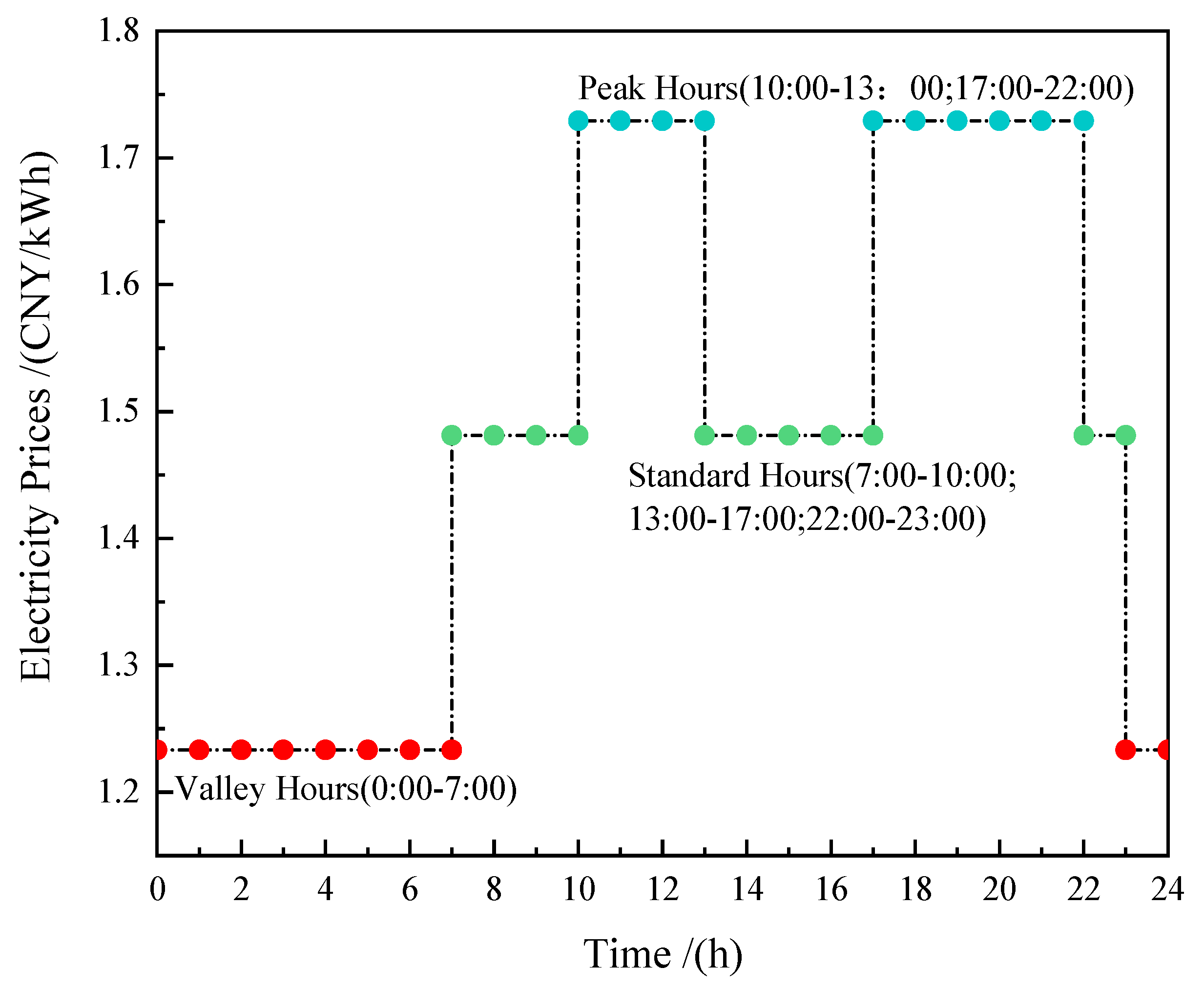
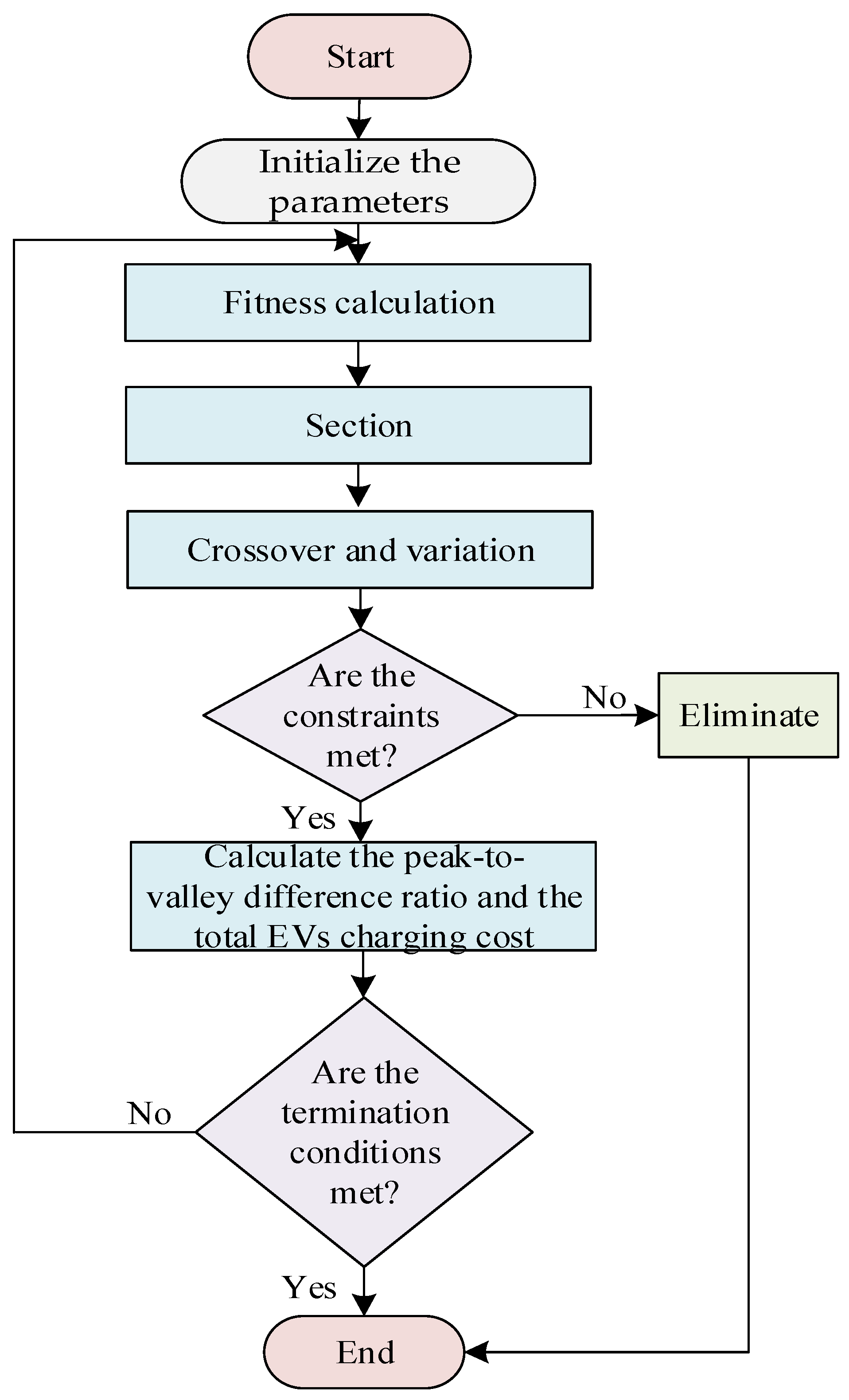
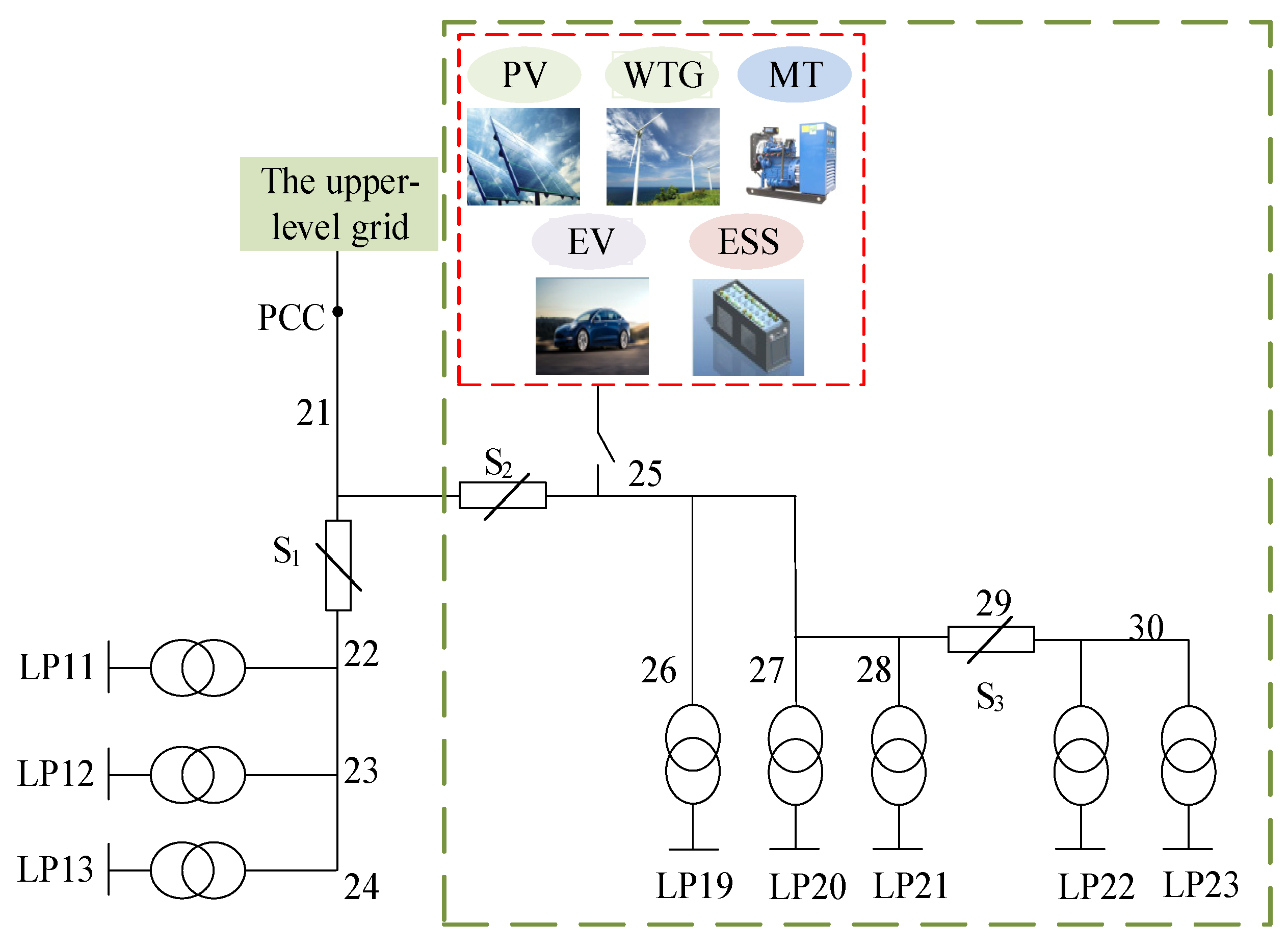
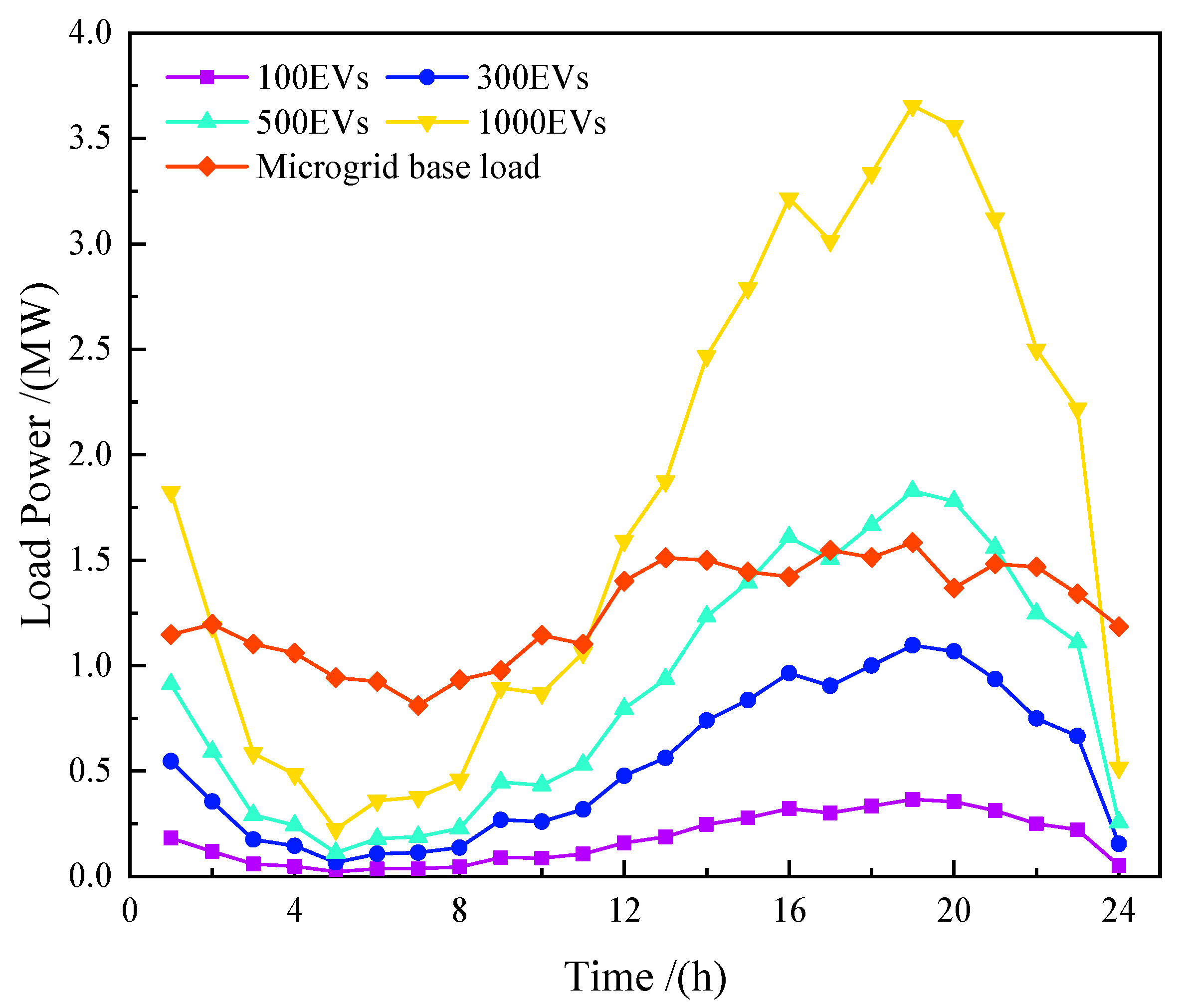
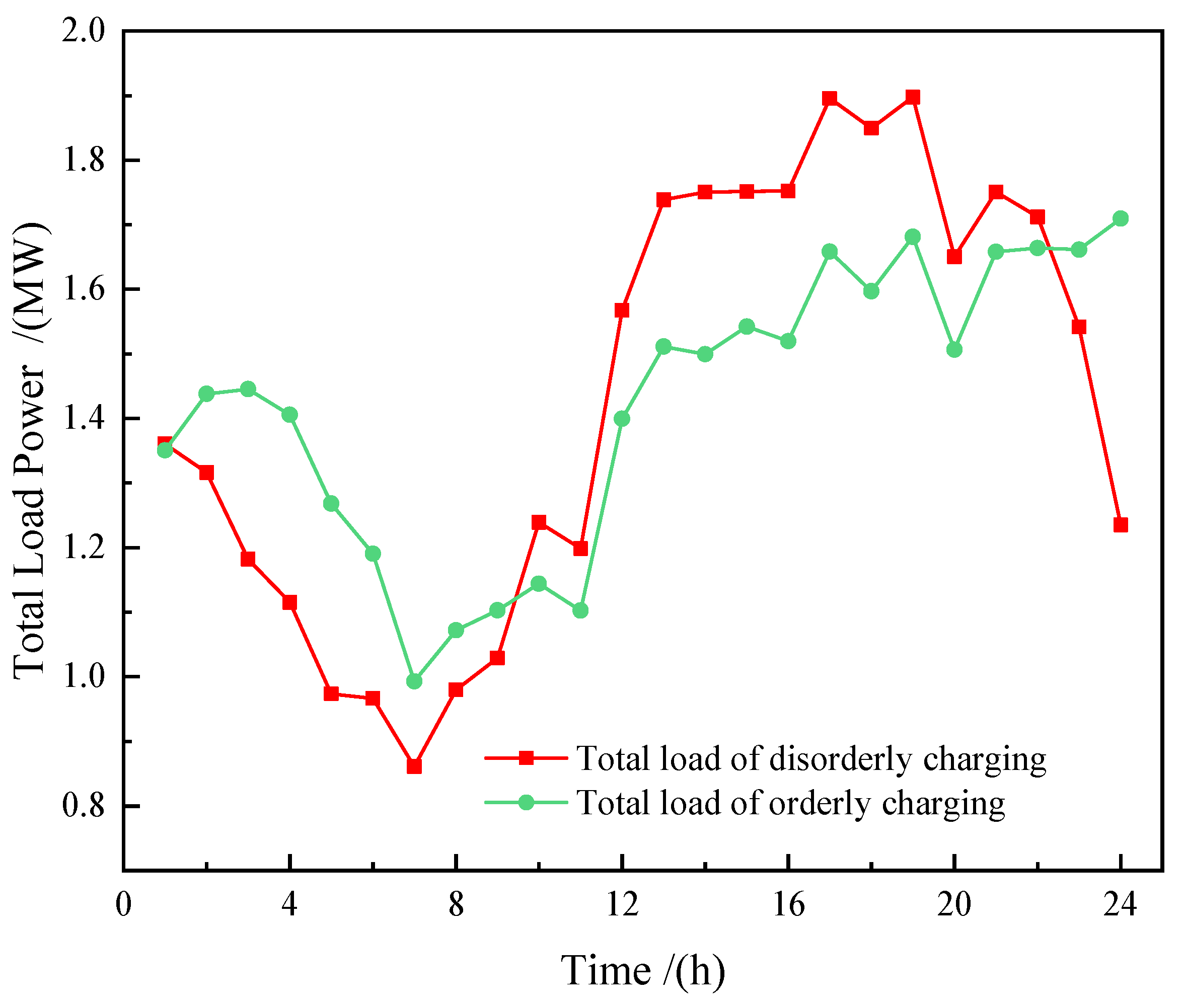

| Parameters | Numerical Value | Parameters | Numerical Value | Parameters | Numerical Value |
|---|---|---|---|---|---|
| Battery capacity | 60 kWh | Fast charging power | 20 kW | Standard deviation of leave home, | 3.24 h |
| 100 km of electricity consumption | 13 kWh | Expect to arrive home, | 17.6 h | Daily mileage expectations, | 3.2 km |
| Driving range | 480 km | Standard deviation of arrive home, | 3.4 h | Standard deviation of daily mileage, | 0.88 km |
| Conventional charging power | 7 kW | Expect to leave home, | 8 h | / | / |
| Mode | Peak Load/MW | Valley Load/MW | Peak–Valley Difference/MW | Peak– Valley Difference Ratio/% | Total EV Charging Costs/CNY |
|---|---|---|---|---|---|
| Before Guidance | 1.90 | 0.86 | 1.03 | 54.63 | 6562.54 |
| After Guidance | 1.71 | 0.99 | 0.72 | 41.92 | 5525.76 |
| Mode | Peak Load/MW | Valley Load/MW | Peak–Valley Difference/MW | Peak–Valley Difference Ratio/% | Total EV Charging Costs/CNY |
|---|---|---|---|---|---|
| Before Guidance | 2.59 | 0.96 | 1.63 | 62.94 | 19,687.63 |
| After Guidance | 2.28 | 1.10 | 1.18 | 51.72 | 14,893.20 |
| Mode | Peak Load/MW | Valley Load/MW | Peak–Valley Difference/MW | Peak–Valley Difference Ratio/% | Total EV Charging Costs/CNY |
|---|---|---|---|---|---|
| Before Guidance | 3.29 | 1.06 | 2.23 | 67.76 | 32,812.71 |
| After Guidance | 2.89 | 1.10 | 1.78 | 61.79 | 24,232.05 |
| Mode | Peak Load/MW | Valley Load/MW | Peak–Valley Difference/MW | Peak–Valley Difference Ratio/% | Total EV Charging Costs/CNY |
|---|---|---|---|---|---|
| Before Guidance | 5.04 | 1.25 | 3.79 | 75.17 | 62,625.43 |
| After Guidance | 3.84 | 1.10 | 2.74 | 71.32 | 39,421.48 |
| Mode | LOLP /(%) | CAIDI/(h/ Customer Interruption) | SAIFI/ (Interruption/ Customer·yr) | SAIDI /(h/Customer·yr) | ASAI /(%) |
|---|---|---|---|---|---|
| Before Guidance | 0.017 | 5.00 | 1.23 | 2.57 | 99.97 |
| After Guidance | 0.005 | 2.00 | 1.16 | 1.66 | 99.98 |
Disclaimer/Publisher’s Note: The statements, opinions and data contained in all publications are solely those of the individual author(s) and contributor(s) and not of MDPI and/or the editor(s). MDPI and/or the editor(s) disclaim responsibility for any injury to people or property resulting from any ideas, methods, instructions or products referred to in the content. |
© 2023 by the authors. Licensee MDPI, Basel, Switzerland. This article is an open access article distributed under the terms and conditions of the Creative Commons Attribution (CC BY) license (https://creativecommons.org/licenses/by/4.0/).
Share and Cite
Weng, Z.; Zhou, J.; Song, X.; Jing, L. Research on Orderly Charging Strategy for Electric Vehicles Based on Electricity Price Guidance and Reliability Evaluation of Microgrid. Electronics 2023, 12, 4876. https://doi.org/10.3390/electronics12234876
Weng Z, Zhou J, Song X, Jing L. Research on Orderly Charging Strategy for Electric Vehicles Based on Electricity Price Guidance and Reliability Evaluation of Microgrid. Electronics. 2023; 12(23):4876. https://doi.org/10.3390/electronics12234876
Chicago/Turabian StyleWeng, Zhipeng, Jinghua Zhou, Xiaotong Song, and Liuming Jing. 2023. "Research on Orderly Charging Strategy for Electric Vehicles Based on Electricity Price Guidance and Reliability Evaluation of Microgrid" Electronics 12, no. 23: 4876. https://doi.org/10.3390/electronics12234876






